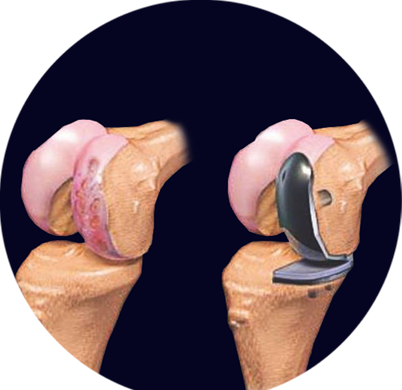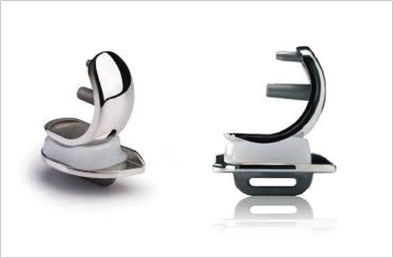Unicondylar knee replacement, also known as partial knee replacement, is a surgical procedure performed to treat advanced osteoarthritis in one compartment of the knee.


Unicondylar knee replacement, also known as partial knee replacement, is a surgical procedure performed to treat advanced osteoarthritis in one compartment of the knee. Unlike total knee replacement, which replaces the entire knee joint, unicondylar knee replacement replaces only the damaged portion of the knee, either the medial (inner) or lateral (outer) compartment. This approach preserves healthy tissue and ligaments, leading to a potentially faster recovery and improved range of motion. In 95% of cases medial compartment is involved and need to be replaced.
Patients who suffer from osteoarthritis might damage only one of the knee compartments. It makes more sense to replace only that part than all the knee components.
In total knee replacement whole compartment of knee is changed.
No long skin cut is needed
Skin cut is long which results in long scar.
Muscle dissection is very minimal.
Muscle of anterior lower thigh need to be cut for joint exposure.
Ligaments in the front and back of the knee remain untouched.
Ligaments of front and sometimes back of knee need to be removed.
Involves lesser bone cuts and soft tissue dissection.
More bone loss as all compartment is changed
Less blood loss.
Blood loss comparatively more than microplasty as more bone is cut.
Less extensive surgery
More extensive procedure
To decide whether patient requires microplasty or Total knee replacement ,he/she has to go through some specific investigation like :
Clinical examination:
knee examination is needed to check for ligament stability, as all ligaments must be intact before going for microplasty and tenderness area over knee joint.
Radiological assessment:
X ray
MRI Scan:
May be needed to confirm ligaments status and meniscus of the normal compartment of the knee
In the microplasty affected compartment (including tibial joint surface and femure joint surface) of knee is surfaced with prosthetic joint which consists of:

After microplasty patient can walk on a same day or 1st day of surgery as per comfort. Knee bend starts on the day of surgery and toilet training can be started from the second day of surgery, so there is no dependency. Patient can do his all works independently as he/she gets discharged from hospital. Sutures can be removed on the 14th or 15th day of surgery .work should be resumed as early as the patient is comfortable according to his work profile, which is usually at the end of 3rd week. As in microplasty normal joint and ligaments are preserved patients can feel more of a normal natural joint and start to adjust with prosthetic joint early than total knee prosthetic joint.
Whether a patient would benefit from microplasty or need a total knee replacement is solely determined by the surgeon’s expertise and experience. Based on the results of the clinical examination or after observing the joint condition during surgery, this choice should is being made. Furthermore, if the patient’s condition is severe and more degenerative ligaments, specifically the PCL and ACL, are involved, microplasty might be modified to a total knee replacement while the patient is being operated on for prognostic purposes.
Please complete the form below to request an appointment. A member of our intake team will follow up with you.
Vraj Complex, 302, 100 Feet Rd, Near Shyamal Cross road, Jodhpur Village, Ahmedabad, Gujarat 380015